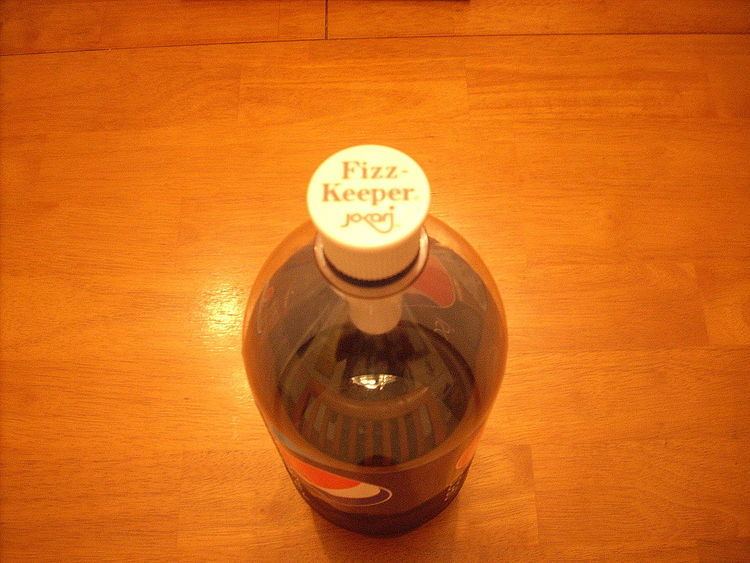 | ||
The Fizz Keeper is a device that is sold as a means for preserving the carbonation in soft drinks. It comprises a small hand pump that screws onto the top of a plastic soft drink bottle, which is used to pump air into the bottle. Pressurizing the bottle in this way, it is claimed by most of those who sell the device, prevents the drink from going flat.
As Joseph A. Schwarcz, Brian Rohrig (of Eastmoor Academy), John P. Williams (of Miami University Hamilton), Sandy Van Natta, Rebecca Knipp, and Reed A. Howald all explain, the mechanism does not, in fact, operate in this fashion because of Henry's Law and Dalton's Law.
Description
When a soft drink bottle is carbonated, it is pressurized with carbon dioxide to higher than the ambient atmospheric pressure. Eventually the dissolved CO2 and the CO2 in the headspace above the liquid reach a dynamic equilibrium, where the amount of CO2 dissolving in the liquid equals the amount of CO2 escaping the solution into the headspace, at a pressure of approximately 2 atmospheres. The bottle remains in this dynamic equilibrium until the first time that the cap is removed.
The first time that the cap is removed from the bottle, the pressure inside the bottle equalizes with the ambient atmospheric pressure. More importantly, however, after the outside air is allowed to mix with the gas inside the bottle the headspace no longer contains pure CO2. Thus the partial pressure of CO2 is substantially reduced, from 2 atmospheres to the partial pressure of CO2 in the Earth's atmosphere, which is approximately 0.0003 atmospheres. In accordance with Henry's Law, the excess CO2 dissolved in the drink comes out of solution. Eventually it reaches a new dynamic equilibrium state, with a much lower partial pressure of CO2 in the headspace and thus a much lower amount of CO2 held in solution.
Pumping pure CO2 back into the bottle would raise that partial pressure, and force more CO2 back into solution. The Fizz Keeper, however, only pumps the normal atmospheric mixture of gases into the bottle, which (by Dalton's Law) does not raise the partial pressure of CO2 far above 0.0003 atmospheres, since only part of the overall increase in pressure within the bottle is attributable to CO2. Hence little to no CO2 goes back into solution and effectively none of the "fizz" is actually returned (since the amount of additional CO2 that dissolves once more is several orders of magnitude lower than the amount that caused visible gas bubbles to form when first escaping the solution).
It takes time for the dissolved CO2 to come out of solution, in the form of gas bubbles that grow and bubble up within the liquid. Thus if the cap is replaced quickly after opening, an intermediate equilibrium state can be maintained, with CO2 previously dissolved in the liquid instead occupying the headspace. However, the CO2 partial pressure only ever decreases on each opening, as more of the gas escapes from the bottle entirely. The Fizz Keeper does not cause that partial pressure to increase significantly. Rohrig also observes from experiment that the Fizz Keeper forms a poorer seal than the bottle's own screw cap, thus allowing CO2 to leak out, and the CO2 partial pressure to decrease, more quickly with the Fizz Keeper on a bottle than with the normal cap.
Although re-pressurizing the bottle with an ordinary atmospheric mixture of gases does not affect the equilibrium state, because it only slightly changes the CO2 partial pressure in the headspace, it does affect the kinetics of how that equilibrium state is reached. The increased overall pressure slows down the rate at which dissolved CO2 comes out of solution. For a few hours the bottle's contents are not in an equilibrium state. The application of the Fizz Keeper extends this period, but by hours not by days. Rohrig reports that this can be and has been easily confirmed by experiment.
The first Fizz Keeper-like device was patented in 1926 by G. Staunton. T.R. Robinson and M.B. Beyer patented the Fizz Keeper itself in 1988, without claiming in the patent that the device maintained a soft drink's "fizz". Several styles of device exist, from the plain piston pump to devices incorporating a bulb and a latch and hinge device to allow liquid to be poured out of a spout without removing the Fizz Keeper from the bottle.
Although the Fizz Keeper does not operate as advertised, it has documented uses as a home science tool and teaching aid, for experimentation in physics. Rohrig has published a book of science experiments that can be performed with the Fizz Keeper. More experiments have been published by Moloney, Spangler, Graham, and Williams et al.. (All are listed in further reading.)
